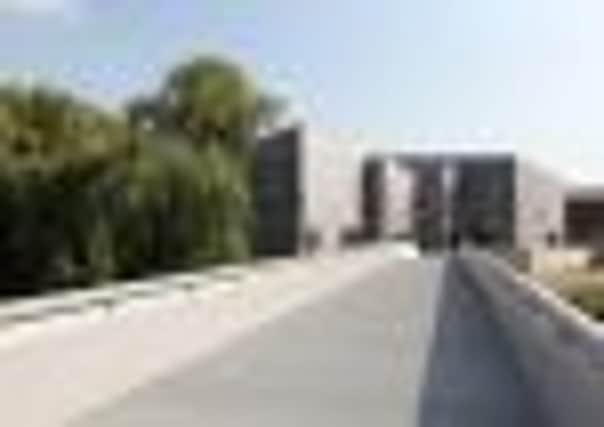Waterfront rebirth


IT may have become an over-used term in recent years but, nevertheless, it is entirely appropriate to say that Wakefield is currently undergoing a renaissance.
For not only is the city seeing the first fruits of major investment in commercial and residential bricks and mortar, but it is on the cusp of a leap forward in cultural terms, too.
Advertisement
Hide AdAdvertisement
Hide AdNext Saturday sees the official opening of The Hepworth Wakefield, one of the biggest arts developments outside London for many years.
The centrepiece of the £26m art gallery, designed by David Chipperfield, is a major collection of sculptures by Wakefield-born Barbara Hepworth, a contemporary of Henry Moore, donated by the Hepworth estate and rarely displayed in public before.
Looming over the River Calder, the external appearance of The Hepworth Wakefield has divided opinion in the city – perhaps all architecture worth its salt should have that effect – with some likening its angular grey concrete form to its neighbouring 19th-century textile mills, others making comparisons with nuclear blockhouses and coal bunkers.
However, civic figureheads, business leaders and the man on the Kettlethorpe omnibus seem united in their desire to see it put the city on the cultural map and to act as a catalyst for more regeneration along the riverbank.
Advertisement
Hide AdAdvertisement
Hide AdFor those who prefer retail to cultural therapy, last weekend was the date to note, when the state-of-the-art new shopping centre, Trinity Walk, let in shoppers for the first time. Sitting close by the recently-rebuilt market hall, it has brought a long-hoped-for department store to Wakefield and should help bring back those shoppers who, in recent years, have deserted the city in favour of Leeds, Meadowhall and other competitors.
The quartet of projects which is shaping the new Wakefield is completed by the Waterfront and Merchant Gate.
The Waterfront – of which The Hepworth Wakefield is an integral component – has seen the restoration of historic but long-disused 18th-century canal warehouses to create business space, joined by sympathetically-designed new buildings for commercial and residential use.
Mixed business and city living space also characterises the recently-completed Merchant Gate, a £140m development which is intended to create a new business hub with the selling point of being just two hours from London via the neighbouring Westgate railway station.
Advertisement
Hide AdAdvertisement
Hide AdAs one of the smaller UK cities – ignoring the fiercely independent towns which make up the wider Wakefield local authority district, its population is well short of 100,000 – there is a perception that Wakefield has spent too long in the shadow of nearby Leeds but also a growing belief it is now rediscovering its confidence and starting to assert its identity once more.
It was, for example, recently voted the third most musically-active city in the country relative to its population, several places ahead of Leeds. As home town of current indie heroes The Cribs and ’70s’ guitar virtuoso Bill Nelson, its place in the pop pantheon is assured, but there is more to it than that.
It boasts, for example, a weekly jazz club, which, thanks to the indefatigable enthusiasm of its founder, former schoolteacher Alec Sykes, attracts international stars to play in a corner of a sports pavilion bar.
In the Yorkshire Philharmonic, Wakefield can lay claim to one of the county’s finest choirs; in Holyground Records, it has the world first true independent record label; while the annual two-day festival in Clarence Park can lay claim to being the UK’s longest-running free musical event.
Advertisement
Hide AdAdvertisement
Hide AdFurther cultural sources of pride are the Theatre Royal, a beautifully-restored example of Frank Matcham’s ornate interior design, which miraculously survived long years as a cinema and bingo club, and the Yorkshire Sculpture Park, at nearby West Bretton, which was hosting exhibitions by major artists long before The Hepworth Wakefield was even a twinkle in an architect’s eye.
It would be remiss to claim everything in the Wakefield garden is blooming, as supporters of the city’s rugby league team would be the first to point out.
Wakefield Trinity – sounds much better than Wakefield Wildcats, doesn’t it? – may have been founder members of the Northern Rugby Union but, owing to a protracted saga over securing a new ground, they face expulsion from the sport’s Super League when the next three-year licences to play at the elite level are awarded this summer.
Nevertheless, despite starting the 2011 season on minus points owing to having gone into administration, the team is putting up a fierce fight, typified by Good Friday’s comeback from 24-4 to beat local rivals Castleford 28-24, and while here is, perhaps, not the place to discuss the rights and wrongs of the league’s licensing system, it is fair to say that one of the game’s traditional clubs deserves better than its lot of the past few years.
Advertisement
Hide AdAdvertisement
Hide AdThat, perhaps, is an epithet which could be applied to Wakefield as a whole – but despite recent adversities, all the signs are that the city is now on a firmly upward course.
From rhubarb to rugby via George Gissing
It was made the county town of the West Riding in 1889, because it was feared that to award the status to either of the much bigger Leeds or Sheffield would have provoked jealousy from the city which missed out.
Wakefield is home to one of the country’s smallest museums, a small house on Thompson’s Yard dedicated to the 19th-century author, George Gissing.
The rugby league action scenes in the 1963 film, This Sporting Life, starring Richard Harris, were filmed at Wakefield Trinity’s Belle Vue ground.